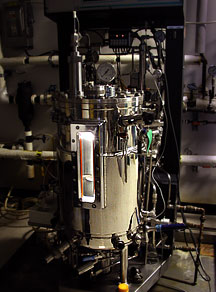

New Fermenter Speeds Research
By Mika Ono
Where does a large new breeding ground for bacteria come in handy? Not in the kitchen. Not in the schools. In the lab, however, such an environment can prove quite useful.
So The Scripps Research Institute recently acquired an 80-liter New Brunswick Scientific BioFlo Pro fermenter, a heating, stirring, glass and metal tank designed to provide ideal conditions for the growth of bacteria.
"We're getting great yields with the new machine," says Research Assistant Kim Masuda, "and we can now do an entire run in a single day."
Masuda, whose dual position includes overseeing the fermenter and working in the Cravatt lab, explains that bacteria are used in a process to produce proteins for research. The fermenter is used to harvest such bacteria and is run as one of the core services on campus, available for use by any Scripps Research investigator for a modest cost-recovery fee.
In her role as part of Professor Benjamin Cravatt's research team, Masuda uses the fermenter to make proteins for investigations that focus on a protein called fatty acid amide hydrolase (FAAH).
FAAH may hold clues for future medical treatments because it modulates central nervous system functions such as pain perception, cognition, feeding, sleep, and locomotor activity. In 2002, the Cravatt and Stevens labs solved the structure of FAAH, which breaks down certain fatty signaling molecules that reside in the lipid membranes of central nervous system cells.
Now, the Cravatt and Stevens labs are extending their work to structures related to FAAH—mutations, inhibitors, and different forms of the protein.
To manufacture the protein for these studies, Masuda collects two to three liters of "starter" broth containing recombinant E. coli cells (which contain the DNA for the FAAH protein), sterilizes and cools a batch of media in the fermenter, and adds the starter broth to the mixture. After several hours, she removes the brew, spins it down, and collects her yield—several vials of gooey cell paste containing the expressed FAAH protein.
"The new fermenter is helping to move our project forward," says Masuda. "It has cut down the time needed to prepare our proteins."
Other Scripps Research labs have also been making use of the new fermenter.
One of these groups is the Paulson lab, which conducts investigations in the field of glycomics, the study of the role of complex sugar chains (glycans or carbohydrates) that decorate the surface of cells in the body. In fact, Scripps Research Professor James Paulson leads an international consortium of scientists at nearly 40 institutions who are funded by a multi-year National Institute of General Medical Science "glue" grant.
Research Assistant Kirk Allin of the Paulson lab notes that the fermenter plays a role in Core D of the glycomics consortium, which supports protein production and carbohydrate synthesis for the grants' investigators. "We use the fermenter for large-scale production of 12 different enzymes," he explains.
So far, Allin is enthusiastic about the performance of the new instrument. "While we are still getting up to speed, the new fermenter is more efficient, less complicated, and quieter than the one it replaced," he observes.
In today's laboratory, much research is dependent on modern instrumentation. Allin, for one, is grateful to have access to it on campus.
"I'd like to extend a big 'thank you' to Emily Holmes, [Scripps Research vice president of research services], for finding the funds to purchase the new fermenter," he says. "She recognized the importance of this machine to the institute."
Send comments to: mikaono[at]scripps.edu

Scripps Research recently acquired a new scientific fermenter to provide ideal conditions for the growth of bacteria used in research.
